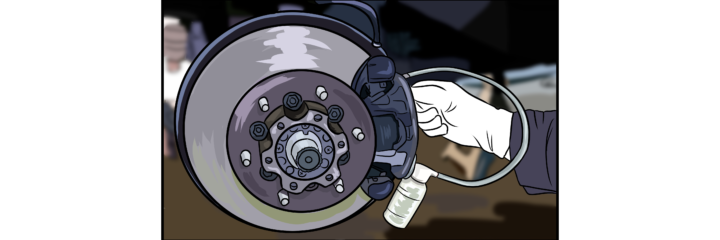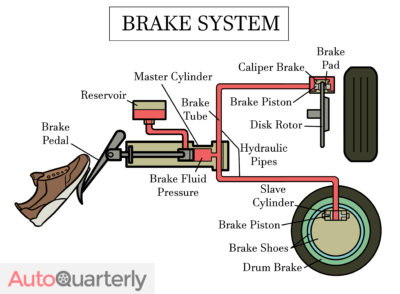The brakes on your car are extremely important. Think about it: if you can’t stop your vehicle properly, what would that outcome look like? We all recognize the importance of breaks, but many suffer from a lack of information around how a modern brake system works.
That’s why today we’ll be taking a look at everything you need to know about a brake fluid flush. This way, if you encounter a situation that requires one you’ll know how to handle it properly. This will be a step-by-step guide, but we’ll also provide some additional information to make sure that you know what you’re actually working with as well.
Keep in mind that we’ll be going over quite a bit of information, so you’ll notice that everything is broken down into sections. We’re sure that many of you may have different backgrounds and levels of experience with car maintenance, so please feel free to skip around if you need to.
Now, with that being said, there is quite a bit of information available, ranging from what brake fluid actually is all the way down to how to change it on your own. Anyone from an auto-repair apprentice to a DIY car-repair expert is in the right place.
What Is Brake Fluid?
Before we dive into the process of a brake fluid flush, it’s definitely important to take a look at what brake fluid is. Plus, to be blunt, not a lot of people actually know how brake fluid works. So let’s take a look.
What Is Brake Fluid?
Brake fluid is a type of fluid that you’ll find in the hydraulic area of your brakes. In short, brake fluid is an essential fluid that you’ll find within modern hydraulic brake systems that lubricates its moving parts and prevents it from overheating or otherwise failing. If you have a clutch system in your car, you’ll notice that the two are actually identical—you can use them interchangeably if you only have one or the other on hand.
How Does Brake Fluid Work?
Brake fluid works by transferring force into pressure more efficiently than a fluidless braking system possibly could. The reason that this helps you slow down faster is simple: it helps your vehicle use a greater amount of force without wearing down on parts. The fluid works in conjunction with your vehicle’s mechanical components. All modern vehicles have brake fluid, so it’s important to understand how to diagnose brake fluid issues and properly maintain your vehicle with an eye on avoiding them.
What Is a Brake Fluid Flush?
Now that you know a little bit about what brake fluid actually is, it’s time to take a look at brake fluid flushes. If you’re concerned about what the process is like, and how much it may cost to have it done professionally, read on.
What Is a Brake Fluid Flush Used For?
Brake fluid may seem like some pretty long-lasting stuff—but as you already know with most other car fluids, nothing lasts forever. The same rule applies to brake fluid, and sometimes it gets a little bit dry. It’s a consumable part of your vehicle’s proper operation, so don’t forget to watch your brake fluid levels closely.
If brake fluid depletion occurs, you’ll notice that your car may not slow down or stop the way it used to. Now, if this is the case, your mechanic may suggest a brake fluid flush. The concept is quite simple: the mechanic will drain out the fluid you already have in your brakes, and simply replace that fluid with new fluid.
How Much Does a Brake Fluid Flush Usually Cost?
Determining the price of a brake fluid flush will usually depend on the type of brake system you have on your vehicle. But don’t panic, we won’t leave you hanging. The average price of a brake fluid flush will usually be around $80, inclusive of parts and labor.
Keep in mind that this price may, but it will usually cost between $70 and $100. Unfortunately, if you do have a luxury vehicle with premium requirements, you can expect to pay a whole lot more.
If you would like to see this broken down, feel free to check out some of these charts. These charts outline the expected price for parts at certain retail locations, as well as the price of a complete flush at several service centers.
We understand that choosing the right brake fluid can be a complicated process, especially for somebody new to maintaining their own vehicle, so check out our list of the best brake fluids to help you narrow down the field before you make your purchase.
When Do I Need a Brake Fluid Flush?
Now that you know what a brake fluid flush is, and how much it may actually cost you, it’s time to take a look at it when you need one. We understand that not everyone trusts their mechanic, so we’ll show you a way to determine a suggested interval to change this fluid at.
If the Mechanic Suggests You Change It
If the mechanic is bleeding your brakes, doing any brake repairs, or during the process of an oil change, they may notice that your fluid needs to be replaced. Most of the time they do have your best interests at heart, so if they do suggest new fluid it may be a good idea to listen. This might cost more than you were hoping to spend, but your safety is worth a lot more than that—and it can help you avoid even more expensive repairs down the line.
Is There a Mileage Range?
There is a mileage range for most things to be changed on modern vehicles. For example, it’s always a good idea to receive an oil change every 3,000 or so miles, depending on your make and model. Luckily, the same rule does apply to brake fluid, so a good interval to consider is every 30,000 miles or five years, whichever comes first. A brake fluid flush will need to be done more frequently if they are being driven a lot, but even vehicles that have been sitting for a while will need less-frequent flushing.
Can I Do a Brake Fluid Flush on My Own?
A great way to save some money is to do a little bit of mechanical work on your own. So in this section, we’ll provide you with a quick list of instructions to handle this repair on your own.
What Are the Steps?
- Ensure that you have all the tools you’ll need to service your vehicle.
- Pop open the hood and locate the master cylinder.
- Open up the master cylinder and use a turkey baster to suck up as much brake fluid as you can.
- Once you get as much as you can, grab your new brake fluid and top the reservoir off.
- Consult your manual to check which calipers you’ll need to bleed first.
- Jack up the car on the side that you need to start from.
- Remove a wheel.
- Locate the bleeder valve.
- Pop the valve open, and have someone pump the brakes until all of the old fluid comes out (it’s usually a dark color).
- Repeat steps 6 through 9 on the other three wheels of your car.
- Top off the master cylinder with fresh fluid to the fill line.
While the process may seem complicated, it’s actually a pretty simple thing to do on your own. Once you’re equipped with a basic tool set and a jack stand, you’ll only need to pay for the new fluid. From start to finish, it should only take you a few hours with a little bit of help. If you need this process visualized, there are several excellent YouTube tutorials that can serve as a guide.
Recap
We know that we went over quite a bit, but we want to make sure that you’re well informed. It may sometimes seem like bleeding your brakes is enough, but in some cases you may need a total replacement of brake fluid.
At the end of the day there are some hefty trust issues with mechanics. Now, while this may be the case, if they suggest a brake fluid flush we definitely recommend getting this done. Failing to do so will lead to problems far greater than losing a few hours and a few dollars.
Making sure your vehicle stops correctly is important for so many reasons, and brake fluid is an essential component to this process. Therefore, always make sure that you consider a brake fluid flush every 30,000 miles.



